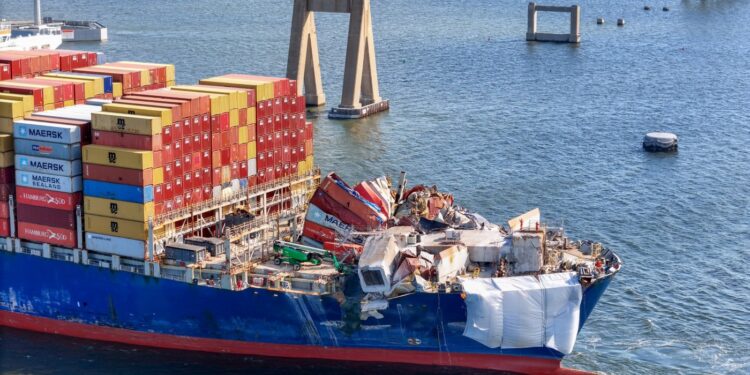
The container ship Dali still sits — empty of containers and with a deep gash in its bow — in the Port of Norfolk. But soon, the behemoth that caused one of the greatest calamities in Baltimore’s history could return to service.
The 984-foot long, 158-foot wide vessel that knocked over the Francis Scott Key Bridge is scheduled to sail to China later this month, according to a filing in federal court this week. There, it’s expected to undergo needed repairs in a dry dock, allowing the vessel to return to its business of delivering cargo around the world.
A spokesperson for the ship’s owner and manager, Grace Ocean Private Ltd. and Synergy Marine, respectively, declined to comment when asked when the ship was expected to return to service. But, experts say, it could be repaired and again ship containers in early 2025.
When the Ever Given, the massive ship that briefly ran aground and blocked the Suez Canal in 2021, underwent repairs, it was back in service within eight months and continues to sail today. The 1,312-foot-long vessel called on a port in Shanghai, China, last week, according to marine tracking data.
Although the Dali’s repairs present a different situation, it could only be a matter of months before it returns to service. Upon the Dali’s arrival in China, a journey expected to take about four weeks, its bow is likely to be entirely replaced by a new, prefabricated one. If that’s the route taken, the ship could be fixed roughly a month after arriving at a dry dock in China, said Sal Mercogliano, a former merchant mariner who hosts the YouTube show “What’s Going On With Shipping?”
Since the Dali crashed into the Key Bridge in the early hours of March 26, killing six construction workers and temporarily blocking the essential shipping channel into Baltimore, there has been a flurry of progress cleaning up the mess. Explosives cut up a huge bridge portion that remained on the Dali, the vessel sailed to Norfolk (while flanked by tugboats), and the channel was cleared of tens of thousands of tons of debris, making way for ships to again regularly call on Baltimore.
The state then selected a builder — construction giant Kiewit — to construct a new span expected to cost roughly $1.7 billion.
Meanwhile, though, the litigation process has really only just begun. The Dali’s Singaporean owner and manager filed a suit in federal court to limit their liability in the disaster and, in response, the City of Baltimore and, more recently, a small propane distributing company, joined others in filing suit against them in U.S. District Court in Maryland.
Claimants have until Sept. 24 (although there is an effort to extend that deadline) to file a claim, but one major shoe has yet to drop. The state of Maryland — which owns the Key Bridge via the Maryland Transportation Authority — has not filed suit, although Attorney General Anthony Brown said in a May news release that the state “will pursue compensation from the responsible parties for the damages caused” by the disaster.
Jennifer Donelan, a spokesperson for the Attorney General’s office, said Friday, “we have no updates at this time.”
The National Transportation Safety Board, the federal agency tasked with investigating what went wrong, is not expected to finalize its report until next year at the earliest. But litigation is expected to last years beyond that.
It’s not an exact comparison, but when the Exxon Valdez supertanker spilled 11 million gallons of oil off the coast of Alaska in 1989, litigation lasted roughly two decades. James Mercante, head of the Admiralty Department at Gallo Vitucci Klar, a firm based in New York, pointed to that incident as an example of an especially lengthy litigation process.
With all the claims and issues involved, unless there are settlements, which Mercante said he did not expect (except for perhaps the injury and death claims), the entire litigation and appeals process involving the Dali could last “seven to 10 years,” he said.
By that point, the state of Maryland should have a new Key Bridge — the structure is expected to open by October 2028 — and the Dali will have likely long returned to the seas.
In the maritime industry, timing is often fickle. Logistics, storms and bureaucracies can slow a project and thus, written into many shipping contracts is “G.W.W.P.” meaning, “God willing, weather permitting.” In the Dali’s case, both times it has moved locations since the bridge collapse, its departure date was at least a few days later than initially anticipated.
Thus, it’s hard to know exactly when the Dali will be back in service, but upon arrival in China, shipyard workers will work quickly to cut out damaged portions of the ship’s bow and replace them with prefabricated portions. Ships are built in sections — akin to “Lego blocks,” said Rik van Hemmen, president of marine engineering consultant Martin & Ottaway — and welded together. As the Dali readies for its voyage to China, workers there could already be preparing a prefabricated portion to attach to the vessel upon its arrival.
“They might be building it right now,” Van Hemmen said Thursday of a potential replacement segment.
The Dali’s classification society, ClassNK, is expected to be among those involved in ensuring the ship is sufficiently repaired. Eventually, the vessel will return to delivering goods. And there’s an economic incentive for that to happen quickly.
“If ships don’t move, they don’t make any money,” Van Hemmen said.






